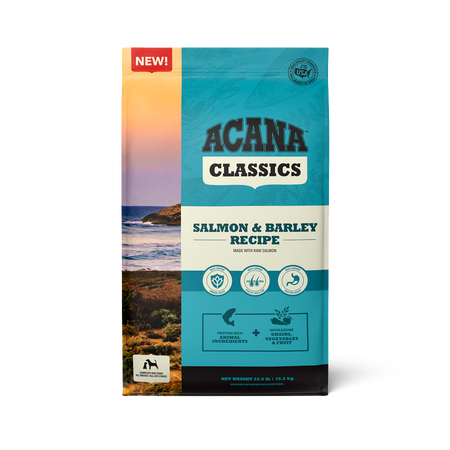
DogFoodAdvisor is reader supported See how
All reviews are 100% impartial but if you buy using links on this page, we may earn a referral fee.
Our Verdict
Acana Classics dry dog food is made up of three recipes which each receive the Dog Food Advisor’s rating, 4.5 stars.
Acana Classics are grain-inclusive recipes, with barley as the primary grain. Barley is a healthy fiber-rich rice alternative containing potassium, phosphorus, and magnesium.
Pros
- No artificial flavors, colors, or preservatives
- Premium ingredients
- Responsibly sourced ingredients
Cons
- Expensive
The table below shows each recipe in this range including our rating and the AAFCO nutrient profile: Growth (puppy), Maintenance (adult), All Life Stages, Supplemental or Unspecified.
| Product line | Rating | AAFCO |
|---|---|---|
| Acana Classics Chicken and Barley Recipe | 4.5 | A |
| Acana Classics, Beef and Barley Recipe | 4.5 | A |
| Acana Classics, Salmon and Barley Recipe | 4.5 | A |
Recipe and Label Analysis
Acana Classics, Salmon and Barley was selected to represent the other products in the line for a detailed recipe and nutrient analysis.
Acana Classics, Salmon and Barley Recipe
Estimated Dry Matter Nutrient Content
Protein
Fat
CarbsCarbohydrates
Salmon, herring meal, pearled barley, whole peas, oat groats, pork fat, whole oats, lentil fiber, natural fish flavor, pea starch, fish oil, dicalcium phosphate, calcium carbonate, potassium chloride, dried kelp, choline chloride, vitamin E supplement, salt, zinc proteinate, vitamin C (ascorbic acid), mixed tocopherols (preservative), taurine, vitamin A supplement, vitamin D3 supplement, iron proteinate, whole apples, whole butternut squash, whole carrots, collard greens, whole pears, whole pumpkin, niacin, thiamine mononitrate, calcium pantothenate, pyridoxine hydrochloride, riboflavin, folic acid, vitamin B12 supplement, copper proteinate, citric acid (preservative), rosemary extract, dried Lactobacillus acidophilus fermentation product, dried Bifidobacterium animalis fermentation product, dried Lactobacillus casei fermentation product.
Fiber (estimated dry matter content) = 6%
Red denotes any controversial items
| Estimated Nutrient Content | |||
|---|---|---|---|
| Method | Protein | Fat | Carbs |
| Guaranteed Analysis | 25% | 15% | NA |
| Dry Matter Basis | 28% | 17% | 47% |
| Calorie Weighted Basis | 24% | 36% | 40% |
Ingredients Analysis
The first ingredient is salmon. Salmon is an oily marine and freshwater fish not only high in protein but also omega 3 fatty acids, essential oils needed by every dog to sustain life.
The second ingredient is herring meal. Because it is considered a meat concentrate, herring meal contains almost 300% more protein than fresh fish itself.
Fish meal is typically obtained from the “clean, dried, ground tissue of undecomposed whole fish and fish cuttings” of commercial fish operations. 1
The third ingredient is cracked pearled barley, this is produced when the seed hull and bran is removed from barley grain. Fiber is distributed throughout the barley grain, rather than being contained within the hull meaning that cracked pearled barley is still a source of fiber.
However, aside from its energy content, this cereal grain is of only modest nutritional value to a dog.
The fourth ingredient is peas. Peas are a quality source of carbohydrates. And like all legumes, they’re rich in natural fiber.
However, peas contain about 25% protein, a factor that must be considered when judging the meat content of this dog food.
The fifth ingredient is oat groats, a whole grain, minimally processed form of oats. With the exception of their caloric content and the fact they’re also gluten-free, oat groats can be considered average in nutritional value.
The sixth ingredient is pork fat, a product from rendering pig meat.
Commonly known as lard, pork fat can add significant flavor to a dog food. And it can be high in linoleic acid, an omega-6 fatty acid essential for life.
Although it may not sound very appetizing, pork fat (in moderate amounts) is actually an acceptable pet food ingredient.
The seventh ingredient is whole oats. Oats are rich in B-vitamins, minerals and dietary fiber.
The eighth ingredient is lentil fiber, a mixture of both soluble and insoluble dietary fiber derived from lentils. Aside from the usual benefits of fiber, this agricultural by-product provides no other nutritional value to a dog.
The ninth ingredient is natural fish flavor, natural flavors doesn’t give us much information about the particular ingredients included in this dog food for flavoring purposes.We’re pleased that the flavorings used are natural, but more details are required to give any further information about these natural flavoring ingredients. Flavorings are used to make the foods more appealing and tasty for our dogs.
From here the list goes on to include a number of other items. But to be realistic, ingredients located this far down the list (other than nutritional supplements) are not likely to affect the overall rating of the product.
This recipe has three notable exceptions.
First taurine, an important amino acid associated with the healthy function of heart muscle. Although taurine is not typically considered essential in canines, some dogs have been shown to be deficient in this critical nutrient.
Next, we note the inclusion of dried fermentation products in this recipe. Fermentation products are typically added as probiotics to aid with digestion.
Probiotics are live yeasts and good bacteria that live in your body and are good for your digestive system. You can take probiotics as supplements or get them through food.
Here the details of the added vitamin sources are listed, used to balance the recipe against AAFCO guidelines.
Nutrient Analysis
Based on its ingredients alone, Acana Classics, Salmon and Barley recipe looks like an above-average dry product.
The dashboard displays a dry matter protein reading of 28.4%, a fat level of 17% and an estimated carbohydrate level of 46.5%.
As a group, the brand features a protein content of 28.4% and a mean fat level of 17.8%. Together these figures suggest a carbohydrate content of 45.8% for the overall product line, alongside a fat-to-protein ratio of 63%.
This means Acana Classics product range contains near-average protein, above-average carbohydrate, near-average fat, when compared to typical type of food dry dog food.
Acana Dog Food Recall History
The following automated list (if present) includes all dog food recalls related to Acana through December 2025.
No recalls noted.
You can view a complete list of all dog food recalls since 2009 here.
Our Rating of Acana Classics Dog Food
ACANA uses responsibly sourced high-quality ingredients in every recipe and contains no man-made chemicals or preservatives. The recipes rely on meat and vegetables for nutritional value and are supplemented with vitamins and minerals.
About
ACANA is a cat and dog food brand owned by Champion Petfoods, a Canadian company. It was founded in 1985 by Canadian entrepreneur Reinhard Mühlenfeld. Originally a tiny operation serving local Alberta farmers, it is now Canada’s largest pet food manufacturer.
Compare Acana Classics Dog Food
How does Acana Classics compare with The Dog Food Advisor's most recommended brands?
A Final Word
The Dog Food Advisor does not accept money, gifts, samples or other incentives in exchange for special consideration in preparing our reviews.
However, we do receive a referral fee from online retailers (like Chewy or Amazon) and from sellers of perishable pet food when readers click over to their websites from ours. This helps cover the cost of operation of our free blog. Thanks for your support.
For more information, please visit our Disclaimer and Disclosure page.






